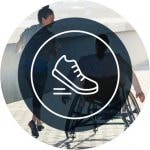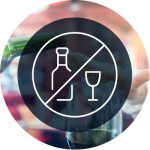Top 4 Tips to Prevent Chronic Diseases
Chronic diseases such as heart disease, cancer, and diabetes are the leading causes of death and disability in the United States. But they are largely preventable. By practicing these four healthy behaviors, you can improve your odds of staying well, feeling good, and living longer.
On This Page: Don’t Smoke | Eat Healthy | Be Active | Limit Drinking


If you don’t smoke, don’t start. If you smoke, get the support you need to quit for good. Quitting smoking lowers your risk of heart disease, lung disease, cancer, and other smoking-related illnesses.
It’s never too late to quit smoking. More than 60% of adults who’ve ever smoked cigarettes have quit.
How To
- Make a quit plan. Making a plan can help you manage stress, urges to smoke, and other challenges when trying to quit.
- Talk to your doctor about using quit-smoking medicine.
- Call 1-800-QUIT-NOW to be connected to your state quitline, where you can speak confidentially with a highly trained coach.
- Don’t give up. Even if you’ve tried to quit before and haven’t been able to, you can still quit for good.
Resources
How to Quit Smoking
Tips From Former Smokers®

Good nutrition is essential to staying healthy at any age. The benefits of healthy eating are significant. People with healthy eating patterns live longer and have less risk of obesity, heart disease, type 2 diabetes, and certain cancers.
For Children
Good nutrition during the first 2 years of life is vital for healthy growth and development. Breastfeeding is the best source of nutrition for most infants. It can reduce the risk of asthma, obesity, type 1 diabetes, ear and respiratory infections, and sudden infant death syndrome (SIDS).
Early eating experiences affect how children eat as they get older. Parents and other caregivers should introduce children to healthy foods from the very beginning. At 6 months old, children can start having foods and drinks other than breast milk and infant formula.
For Adults
A healthy eating plan includes a variety of fruits, vegetables, whole grains, lean protein, and low-fat dairy products and limits added sugars, saturated fats, and sodium. Healthy eating can work for everyone’s tastes, traditions, culture, and budget.
How To
- Choose water (tap or unsweetened, bottled, or sparkling) over sugary drinks.
- Focus on whole fruits. They can be fresh, frozen, canned, or dried.
- Eat a variety of vegetables and add them to mixed dishes like casseroles, sandwiches, and wraps.
- Choose whole-grain versions of common foods, such as bread, pasta, and tortillas.
- Eat a variety of protein foods, such as beans, soy, seafood, lean meats, poultry, and unsalted nuts and seeds.
- Choose low-fat (1%) or fat-free (skim) dairy. You’ll get the same amount of calcium and other nutrients as whole milk, but with less saturated fat and calories.
Get more details at MyPlate [PDF – 48 KB]
Resources
Rethink Your Drink
How to Reduce Sodium
Infant and Toddler Nutrition
Healthy Eating for a Healthy Weight
Healthy Eating Tips

Physical activity is one of the best ways you can improve your health now and in the future. Everyone can get the health benefits of physical activity—no matter their age, abilities, shape, or size.
Adults need two kinds of physical activity:
- Aerobic physical activity—such as brisk walking, biking, dancing, or yard work—that gets you breathing harder and your heart beating faster.
- Muscle-strengthening physical activity that works all major muscle groups, such as lifting weights, working with resistance bands, push-ups, or squats.
Physical activity is important for people of all ages. See how much you need.
If you can’t get the recommended amounts of physical activity because of chronic conditions or disabilities, you should be as physically active as you can. Some physical activity is better than none.
How To
- Talk to your doctor first if you have a chronic condition like diabetes or heart disease.
- Get support from your friends and family. Invite them to get active with you!
- Start slowly and add time, frequency, or intensity every week.
- Schedule physical activity for times in the day or week when you’re most energetic.
- Plan ahead. Make physical activity part of your daily or weekly schedule.
- Walk instead of driving to places nearby. If you drive, park farther away from your destination and walk.
- Take the stairs instead of escalators or elevators, if you’re able, and do so as often as possible.
- Move more and sit less throughout the day.
Resources
Overcoming Barriers to Physical Activity
Making Physical Activity a Part of a Child’s Life
Making Physical Activity a Part of an Older Adult’s Life
Physical Activity and Cancer
Physical Activity for Adults With Chronic Health Conditions and Disabilities

Excessive alcohol use, over time, can lead to high blood pressure, heart disease, stroke, liver disease, and various cancers. Excessive alcohol use includes:
- Binge drinking, defined as consuming 4 or more drinks on an occasion for a woman or 5 or more drinks on an occasion for a man. See What Is a Standard Drink?
- Heavy drinking, defined as 8 or more drinks per week for a woman or 15 or more drinks per week for a man.
- Any alcohol use by pregnant women or anyone younger than 21.
To reduce the risk of alcohol-related harms, the 2020–2025 Dietary Guidelines for Americans recommends that adults of legal drinking age can choose not to drink or to drink in moderation by limiting intake to 2 drinks or less in a day for men or 1 drink or less in a day for women, on days when alcohol is consumed.
How To
- If you don’t drink, don’t start.
- If you do drink, drink in moderation.
- Check your alcohol use and make a customized plan for drinking less.
- If you need help to stop drinking, talk to your doctor or call 1-800-662-HELP (TTY: 1-800-487-4889). This confidential, free service provides referrals to local treatment facilities, support groups, and community organizations. You can also visit the online treatment locator.
Resources
Tool to Check Your Drinking
Why Drinking Less Matters